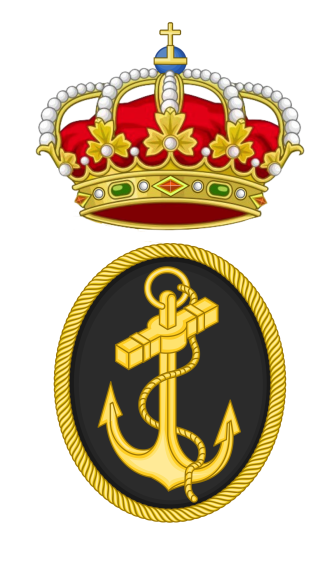
The Spanish Navy or officially, the Armada, is the maritime branch of the Spanish Armed Forces and one of the oldest active naval forces in the world. The Spanish Navy was responsible for a number of major historic achievements in navigation, the most famous being the discovery of America and the first global circumnavigation by Elcano. For several centuries, it played a crucial logistical role in the expansion and consolidation of the Spanish Empire, and defended a vast trade network across the Atlantic Ocean between the Americas and Europe, and the Manila Galleon across the Pacific Ocean between the Philippines and the Americas.

Corregidor is an island located at the entrance of Manila Bay in the southwestern part of Luzon in the Philippines, and is considered part of Cavite City and thus the province of Cavite. It is located 48 kilometres (30 mi) west of Manila, the nation's largest city and one of its most important seaports for centuries since the Spanish colonial period. Due to its strategic location, Corregidor has historically been fortified with coastal artillery batteries to defend the entrance of Manila Bay and Manila itself from attacks by enemy warships.
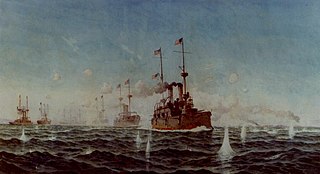
The Battle of Manila Bay, also known as the Battle of Cavite, took place on 1 May 1898, during the Spanish–American War. The American Asiatic Squadron under Commodore George Dewey engaged and destroyed the Spanish Pacific Squadron under Contraalmirante Patricio Montojo. The battle took place in Manila Bay in the Philippines, and was the first major engagement of the Spanish–American War. The battle was one of the most decisive naval battles in history and marked the end of the Spanish colonial period in Philippine history.

Cavite City, officially the City of Cavite, is a 2nd class component city in the Philippines. According to the 2020 census, it has a population of 100,674 people.
The Manila galleon, originally known as La Nao de China, and Galeón de Acapulco, refers to the Spanish trading ships that linked the Spanish Crown's Viceroyalty of New Spain, based in Mexico City, with its Asian territories, collectively known as the Spanish East Indies, across the Pacific Ocean. The ships made one or two round-trip voyages per year between the ports of Acapulco and Manila from the late 16th to early 19th century. The name of the galleon changed to reflect from which city the ship sailed, setting sail from Cavite, in Manila Bay, at the end of June or first week of July, starting the return journey (tornaviaje) from Acapulco in March–April of the next calendar year, and returning to Manila in June–July.

The naval Battle of Gibraltar took place on 25 April 1607, during the Eighty Years' War, when a Dutch fleet surprised and engaged a Spanish fleet anchored at the Bay of Gibraltar. During the four hours of action, most of the Spanish ships were destroyed.
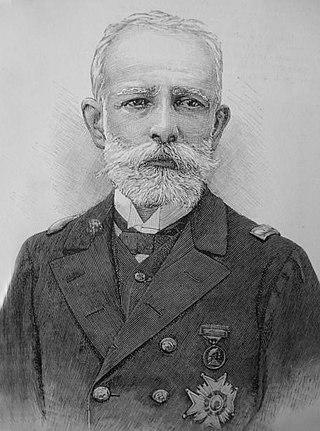
Rear Admiral Patricio Montojo y Pasarón was a career Spanish naval officer who commanded Spain's Pacific Squadron based in the Philippines during the Spanish–American War. Considered a man of high ability and experience, he was given the difficult task of defending the Spanish Philippines with a small navy and low supplies against a larger U.S. Asiatic Squadron. Despite his valor and determination, Montojo's navy was defeated at the decisive Battle of Manila Bay by U.S. Navy Commodore George Dewey. He was later held accountable for the defeat and was court-martialed in Spain. Although the decision was later overturned, Montojo was still discharged from the Spanish Navy.

The Philippine Navy (PN) is the naval warfare service branch of the Armed Forces of the Philippines. It has an estimated strength of 24,500 active service personnel, including the 10,300-strong Philippine Marine Corps. It operates 90 combat vessels, 16 auxiliary vessels, 25 manned aircraft and 8 unmanned aerial vehicles. Tracing its roots from the Philippine Revolutionary Navy on May 20, 1898, while its modern foundations were created during the creation of the Offshore Patrol on February 9, 1939, the PN is currently responsible for naval warfare operations and maritime patrol missions within the Philippine Waters, as well as ensuring the protection of the Philippine's maritime interests, including the West Philippine Sea and Benham Rise.

The galleon San Diego was built as the trading ship San Antonio before hastily being converted into a warship of the Spanish Navy. On December 14, 1600, the fully laden San Diego was engaged by the Dutch warship Mauritius under the command of Admiral Olivier van Noort a short distance away from Fortune Island, Nasugbu, Philippines. Since San Diego couldn't handle the extra weight of her cannons, which led to a permanent list and put the cannon portholes below sea level, she was sunk without firing a single shot in response. The Dutch were later reported firing upon and hurling lances at the survivors attempting to climb aboard the Mauritius.
Juan Niño de Tabora, was a Spanish general and colonial official. From June 29, 1626, until his death on July 22, 1632, he was governor of the Philippines.
Diego Fajardo Chacón was a Spanish military officer and governor of the Philippines, from August 11, 1644 to July 25, 1653.

The Cavite Peninsula is a peninsula extending northeast into Manila Bay from the coastal town of Noveleta in Cavite province in the Philippines. The northern tip of the peninsula is geographically the northernmost part of the province of Cavite.

The Battles of La Naval de Manila or Battle of Manila Bay were a series of five naval battles fought in the waters of the Spanish East Indies in the year 1646, in which the forces of the Spanish Empire repelled various attempts by forces of the Dutch Republic to invade Manila, during the Eighty Years' War. The Spanish forces, which included many native volunteers, consisted of two, and later, three Manila galleons, a galley and four brigantines. They neutralized a Dutch fleet of nineteen warships, divided into three separate squadrons. Heavy damage was inflicted upon the Dutch squadrons by the Spanish forces, forcing the Dutch to abandon their invasion of the Philippines.
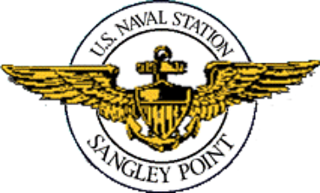
Naval Station Sangley Point was a communication and hospital facility of the United States Navy which occupied the northern portion of the Cavite City peninsula and is surrounded by Manila Bay, approximately eight miles southwest of Manila, the Philippines. The station was a part of the Cavite Navy Yard across the peninsula. The naval station had a runway that was built after World War II, which was used by U.S. Navy Lockheed P-2 Neptune, Lockheed P-3 Orion, and Martin P4M Mercator maritime patrol and anti-submarine warfare aircraft. An adjacent seaplane runway, ramp area and seaplane tender berths also supported Martin P5M Marlin maritime patrol aircraft until that type's retirement from active naval service in the late 1960s. NAS Sangley Point/NAVSTA Sangley Point was also used extensively during the Vietnam War, primarily for U.S. Navy patrol squadrons forward deployed from the United States on six-month rotations. The naval station was turned over to the Philippine government in 1971. It is now operated by the Philippine Air Force and Philippine Navy.

The history of the Philippines from 1565 to 1898 is known as the Spanish colonial period, during which the Philippine Islands were ruled as the Captaincy General of the Philippines within the Spanish East Indies, initially under the Viceroyalty of New Spain, based in Mexico City, until the independence of the Mexican Empire from Spain in 1821. This resulted in direct Spanish control during a period of governmental instability there. The Philippines was under direct royal governance from 1821 to 1898.

Naval Station Pascual Ledesma, also known as Cavite Naval Base or Cavite Navy Yard, is a military installation of the Philippine Navy in Cavite City. In the 1940s and '50s, it was called Philippine Navy Operating Base. The 9-hectare (22-acre) naval base is located at the easternmost end of Cavite Point in the San Roque district of the city. Via traffic lane, this naval establishment is next to the famous Samonte Park. It was the former extension of U.S. Naval Station Sangley Point which is now Naval Station Heracleo Alano. In 2009, it was named after Cmdre. Pascual Ledesma, a leader of the Philippine Revolution and the first Officer-In-Command of the Philippine Navy.
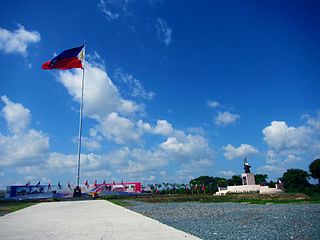
The Battle of Alapan was fought on May 28, 1898, and was the first military victory of the Filipino Revolutionaries led by Emilio Aguinaldo after his return to the Philippines from Hong Kong. After the American naval victory in the Battle of Manila Bay, Aguinaldo returned from exile in Hong Kong, reconstituted the Philippine Revolutionary Army, and fought against the Spanish troops in a garrison in Alapan, Imus, Cavite. The battle lasted for five hours, from 10:00 A.M. to 3:00 P.M.

The Raid on Manila of January 1798 was a Royal Navy false flag military operation during the French Revolutionary Wars intended to scout the strength of the defences of Manila, capital of the Spanish Philippines, capture a Manila galleon and assess the condition of the Spanish Navy squadron maintained in the port. Spain had transformed from an ally of Great Britain in the War of the First Coalition into an enemy in 1796. Thus, the presence of a powerful Spanish squadron at Manila posed a threat to the China Fleet, an annual convoy of East Indiaman merchant ships from Macau in Qing Dynasty China to Britain, which was of vital economic importance to Britain. So severe was this threat that a major invasion of the Spanish Philippines had been planned from British India during 1797, but had been called off following the Treaty of Campo Formio in Europe and the possibility of a major war in India between the British East India Company and the Kingdom of Mysore.

Naval Base Manila, Naval Air Base Manila was a major United States Navy base south of the City of Manila, on Luzon Island in the Philippines. Some of the bases dates back to 1898, the end of the Spanish–American War. Starting in 1938 civilian contractors were used to build new facilities in Manila to prepare for World War II. Work stopped on December 23, 1941, when Manila was declared not defendable against the Empire of Japan southward advance, which took over the city on January 2, 1942, after the US declared it an open city. US Navy construction and repair started in March 1945 with the taking of Manila in the costly Battle of Manila ending on March 2, 1945. Naval Base Manila supported the Pacific War and remained a major US Naval Advance Base until its closure in 1971.

The United States Navy held a number of bases in the Philippines Islands in the Pacific Ocean. Most were built by the US Navy Seabees, Naval Construction Battalions, during World War II. The US Naval Bases in Philippines were lost to the Empire of Japan in December 1941 during the Philippines campaign of 1941–1942. In February 1945 the United States Armed Forces retook the Philippines in the Battle of Manila in 1945. Before the captured US bases on Luzon were retaken the US Navy Seabees built a new large base, Leyte-Samar Naval Base, on the Philippine Island of Leyte, starting in October 1944.















